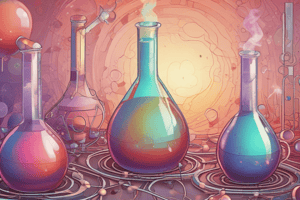Podcast
Questions and Answers
What is the type of reaction in which a single compound breaks down into two or more substances?
What is the type of reaction in which a single compound breaks down into two or more substances?
- Replacement reaction
- Synthesis reaction
- Combustion reaction
- Decomposition reaction (correct)
Chemical equations can be balanced by adding new reactants or products.
Chemical equations can be balanced by adding new reactants or products.
False (B)
What is the purpose of coefficients in a chemical equation?
What is the purpose of coefficients in a chemical equation?
To indicate the mole ratio of reactants and products
The process of ensuring that the number of atoms of each element is the same on both the reactant and product sides of a chemical equation is called _______________.
The process of ensuring that the number of atoms of each element is the same on both the reactant and product sides of a chemical equation is called _______________.
Match the following types of chemical reactions with their definitions:
Match the following types of chemical reactions with their definitions:
What is the purpose of a chemical equation?
What is the purpose of a chemical equation?
Flashcards are hidden until you start studying
Study Notes
Chemical Reactions
- A process in which one or more substances are converted into new substances
- Involves a change in the chemical bonds between atoms
- Can be classified into different types:
- Synthesis reaction: Two or more substances combine to form a new compound
- Decomposition reaction: A single compound breaks down into two or more substances
- Replacement reaction: One element replaces another element in a compound
- Combustion reaction: A substance reacts with oxygen, often producing heat and light
Chemical Equations
- A symbolic representation of a chemical reaction
- Uses chemical formulas and symbols to represent reactants and products
- Components of a chemical equation:
- Reactants: Substances that undergo a chemical change
- Products: Substances formed as a result of the reaction
- Arrow: Indicates the direction of the reaction
- Coefficients: Numbers in front of formulas to indicate the mole ratio of reactants and products
- Balancing a chemical equation:
- Ensures that the number of atoms of each element is the same on both the reactant and product sides
- Coefficients are added to formulas to achieve balance
- Importance of chemical equations:
- Allows for quantitative predictions about the reaction
- Helps in identifying the reactants and products
- Enables the calculation of the amount of reactants required or products formed
Chemical Reactions
- Chemical reactions involve the conversion of one or more substances into new substances, resulting in a change in chemical bonds between atoms.
- Reactions can be classified into four main types:
- Synthesis reactions: Formation of a new compound from two or more substances, e.g., 2H2 + O2 → 2H2O.
- Decomposition reactions: Breakdown of a single compound into two or more substances, e.g., 2H2O → 2H2 + O2.
- Replacement reactions: Substitution of one element with another in a compound, e.g., Zn + CuSO4 → ZnSO4 + Cu.
- Combustion reactions: Reaction of a substance with oxygen, often producing heat and light, e.g., 2CH4 + 3O2 → 2CO2 + 3H2O.
Chemical Equations
- Chemical equations are symbolic representations of chemical reactions, using chemical formulas and symbols to depict reactants and products.
- Key components of a chemical equation:
- Reactants: Substances that undergo a chemical change, e.g., H2 and O2 in 2H2 + O2 → 2H2O.
- Products: Substances formed as a result of the reaction, e.g., H2O in 2H2 + O2 → 2H2O.
- Arrow (→): Indicates the direction of the reaction, from reactants to products.
- Coefficients: Numbers in front of formulas to indicate the mole ratio of reactants and products, e.g., 2 in 2H2 + O2 → 2H2O.
- Balancing a chemical equation is crucial to ensure that the number of atoms of each element is the same on both reactant and product sides.
- Importance of chemical equations:
- Enables quantitative predictions about the reaction, such as the amount of products formed.
- Helps in identifying the reactants and products involved in the reaction.
- Allows for the calculation of the amount of reactants required or products formed.
Studying That Suits You
Use AI to generate personalized quizzes and flashcards to suit your learning preferences.




